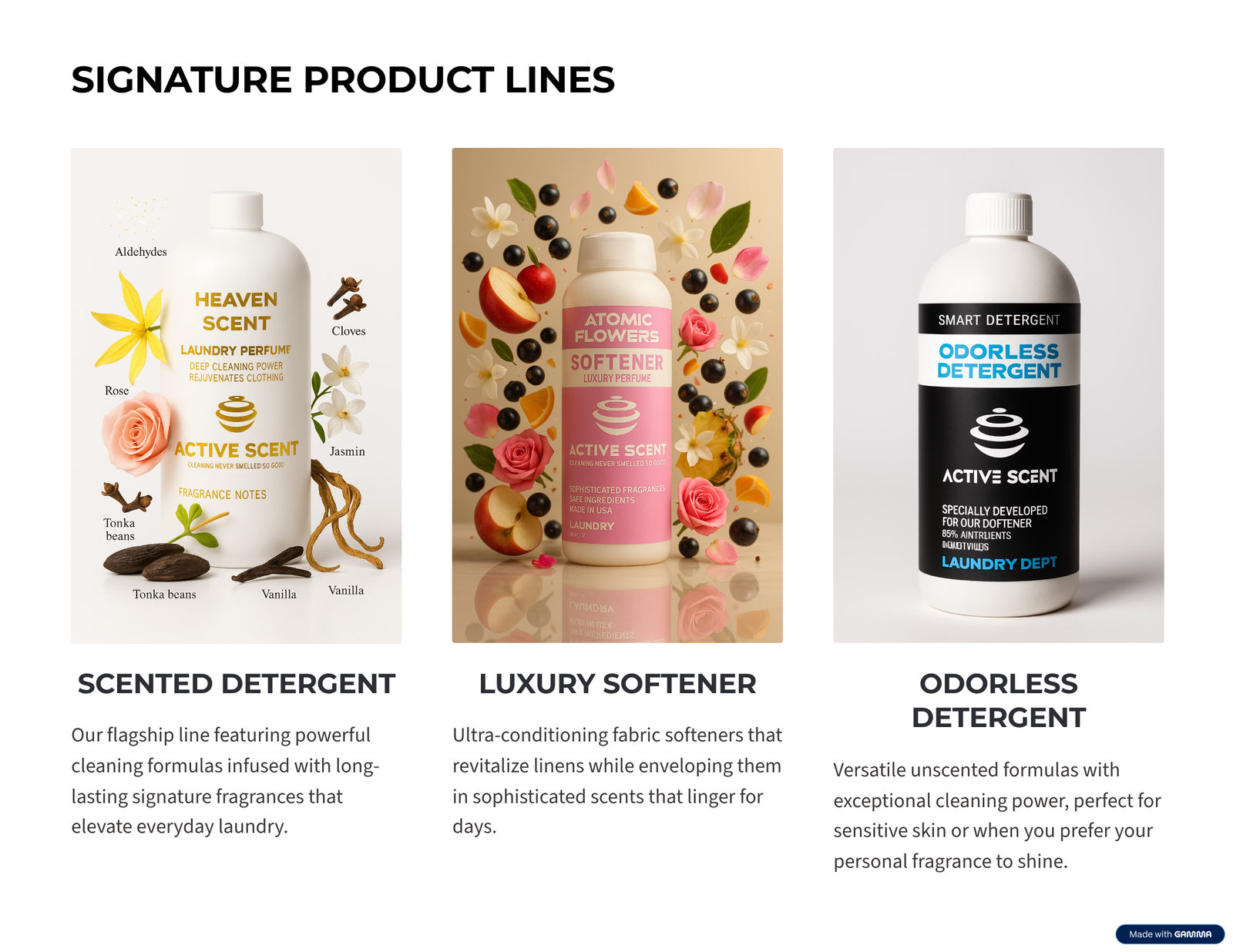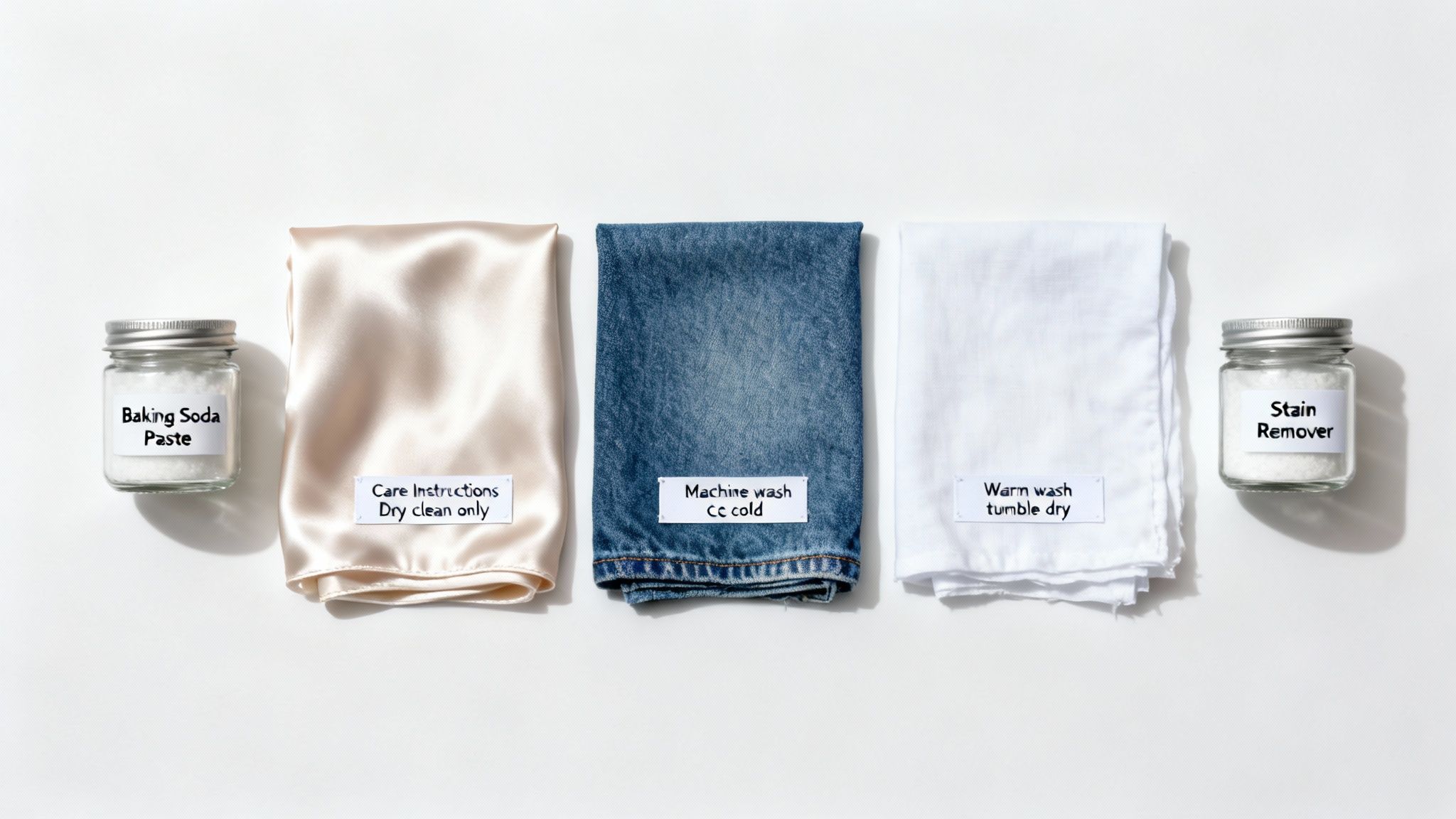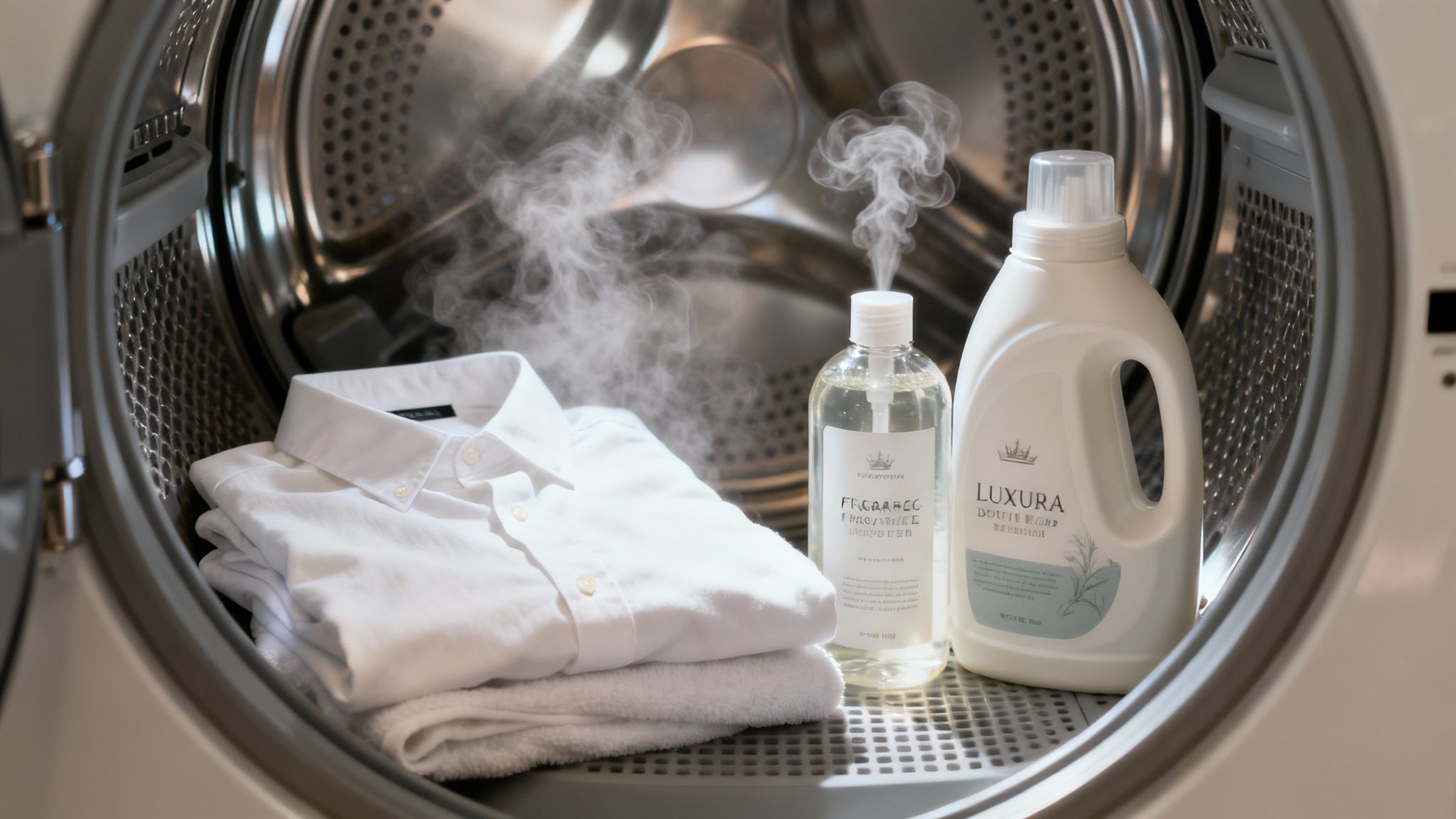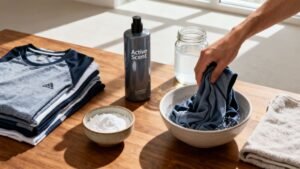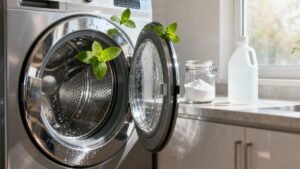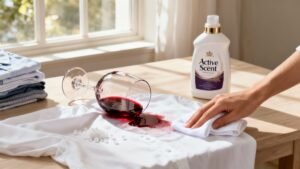
BEST LUXURY LAUNDRY DETERGENT – LONG LASTING SCENTS – (Free Shipping on Orders Over $49)
How to Get Red Wine Out Like a Pro
When it comes to red wine, there’s one golden rule that trumps all others: act fast. Your immediate reaction can make the difference between a forgotten mishap and a permanent, ugly stain. The goal is to gently blot the fresh spill with a clean, dry cloth, absorbing as much of the wine as you can before it has a chance to settle in. Whatever you do, don't rub. That’s a one-way ticket to spreading the stain and pushing it even deeper into the fabric.
Your First Five Minutes After A Red Wine Spill
We’ve all been there. That heart-stopping, slow-motion moment when a full glass of Cabernet goes tumbling. What you do right then—in those critical first five minutes—is more important than anything that comes after. Forget the frantic scrubbing or reaching for the nearest harsh chemical. Your emergency response plan is all about two things: containment and absorption.
This isn't just an old wives' tale. The data backs it up. You can achieve a staggering 90% success rate just by treating a fresh stain within a few minutes. Acting quickly stops the wine’s chromogens—the compounds that give it that beautiful ruby color—from permanently bonding with the fabric fibers.
Blot, Don't Rub
Your gut instinct might be to scrub furiously at the spot. This is the single biggest mistake you can make. All that rubbing does is grind the wine particles deeper into the fabric's weave, making the stain bigger and a whole lot harder to get out.
Instead, grab a clean, dry cloth or a few paper towels. Gently blot the area. Press down firmly, lift, and move to a clean section of the cloth. Keep doing this until you aren't pulling up any more liquid. This simple technique lifts the wine out of the fabric instead of grinding it further in. For a closer look at tackling stains on specific clothes, our guide on how to remove stains from shirts is a great resource.
Using Household Allies
Once you’ve blotted up as much as possible, a few common kitchen staples can be your best friends. These quick fixes are incredibly effective at preventing the stain from setting while you get ready for a proper wash with a high-quality detergent.
- Salt: Don’t be shy with it. Cover the entire stain with a thick layer of regular table salt. The salt crystals act like a magnet, drawing the wine up and out of the fibers. Let it sit for at least 10-15 minutes, or until you see it turn pink, then just scrape it away.
- Club Soda: The carbonation in club soda can work wonders to lift a fresh stain. Pour a little bit directly onto the spill and continue to blot gently.
Key Takeaway: In those first few minutes, your job isn't to erase the stain completely. It's to stop it from becoming a permanent guest. Blotting and using an absorbent like salt are the perfect first steps to set yourself up for a successful wash.
For a major spill, especially on something you can't just toss in the wash like a carpet, you need a solid game plan. For a comprehensive, easy-to-follow guide with immediate steps, this resource on how to clean red wine from a carpet step-by-step is fantastic.
Immediate Action Stain Removal Guide
When disaster strikes, you often have to work with what's on hand. Here’s a quick rundown of some common household items you can use in a pinch to tackle a fresh red wine stain before it sets.
| Method | Best For | How It Works | Pro Tip |
|---|---|---|---|
| Table Salt | Any absorbent fabric (cotton, linen) | The salt crystals draw the liquid out of the fibers through osmosis, absorbing the wine. | Be generous! Create a thick mound covering the entire stain for maximum absorption. |
| Club Soda | Tightly woven fabrics, upholstery | The carbonation helps to lift the stain particles from the fabric, making them easier to blot away. | Pour slowly to avoid oversaturating the area. Continue blotting, don't let it air dry. |
| Baking Soda Paste | Sturdier fabrics, like denim or canvas | Creates a thick paste (mix 3 parts baking soda to 1 part water) that pulls the stain out as it dries. | Apply the paste, let it dry completely, then vacuum or brush off the residue before washing. |
| White Vinegar & Soda | Synthetic fabrics and clothing | The vinegar's acidity helps break down the pigments, while the club soda lifts the stain. | Mix equal parts white vinegar and club soda. Apply, blot, and repeat as needed. |
These methods are fantastic first-aid treatments for a spill. They're designed to stop the stain in its tracks, making the final wash with a powerful detergent like Active Scent far more effective.
Matching the Method to the Mess
When you're staring down a fresh red wine spill on your favorite blouse, the fabric itself is your most important guide. Let's be honest, treating delicate silk the same way you’d attack a stain on rugged denim is a recipe for disaster. A one-size-fits-all approach is the fastest way to faded colors, damaged fibers, or a stain that decides to stick around for good.
Before you do anything else, find the garment’s care label. That tiny tag is your playbook, spelling out exactly what the fabric can handle. Ignoring it is like trying to find your way in a new city without a map—you might get lucky, but you’re far more likely to end up somewhere you really don't want to be.
Choosing Your Treatment Wisely
The world of stain removal is vast, from simple kitchen cupboard solutions to powerful commercial products. A quick paste of baking soda and water might work wonders on sturdy cotton, but it could be far too abrasive for something like silk or fine wool.
Those more delicate fabrics demand a gentler touch. Materials like silk are notoriously fussy about harsh chemicals and rough handling. For these cherished items, a careful spot treatment followed by a specialized wash is non-negotiable. If you're dealing with silk, our guide on how to hand-wash silk properly walks you through the exact steps to protect its luxurious feel.
The sheer number of us who have dealt with a red wine spill means there are countless home remedies out there. It’s a surprisingly common problem—a YouGov poll of 3,534 adults confirms just how many people have faced this exact laundry nightmare. The survey even explored the old trick of using white wine to dilute the red, a testament to our collective creativity in a crisis.
Comparing Common Stain Removal Methods
Your choice of method should always, always align with the fabric. Let’s break down a few common approaches and where they shine:
- Baking Soda Paste: This is your go-to for durable fabrics like cotton and canvas. Its mild abrasive quality helps lift the stain, but keep it far away from silks or fine knits.
- White Vinegar Solution: A 50/50 mix of white vinegar and water can be a great ally against wine pigments on synthetics like polyester. Just be sure to test it on a hidden spot first.
- Hydrogen Peroxide & Dish Soap: This is the heavy-hitter, often reserved for white fabrics because peroxide can have a bleaching effect. It can work miracles on set-in stains but is way too risky for dark or vibrant colors.
Expert Tip: No matter what you use, always do a spot test on a hidden part of the garment, like an inside seam. This one simple step has saved me from more cleaning catastrophes than I can count.
Ultimately, knowing the material you're working with is the key to winning the battle against red wine. By matching your method to the mess, you preserve the integrity of your fabric and get that clean, flawless finish you’re after.
The Final Wash: Your Victory Lap
You’ve acted fast and pre-treated the stain like a pro. Now comes the final, crucial step: the machine wash. This isn't just about rinsing away the residue; this is the moment you obliterate every last trace of that red wine spill and restore your garment to its original, flawless state. At Active-Scent.com, we believe laundry never smelled so good! This is where POWERFUL DETERGENTS FUSED WITH LUXURIOUS FRAGRANCES transform a chore into a ritual.
Active Scent's odor-free laundry detergent has been carefully formulated for a deep and effective clean, without competing fragrances. It’s the ultimate neutral base, created to perfectly complement our range of luxury scented fabric softeners. We call it powerful cleaning with zero interference. This allows the bold, mysterious, and unforgettable olfactory statements of our fabric softeners to truly shine.
Inspired by the spirit of iconic French houses like Dior and Chanel, our fragrances are a bold tribute to renowned perfumery. Imagine deep, earthy patchouli fusing with the burning radiance of amber, or fiery pimento berries igniting a composition with spice and warmth. It’s a sensory experience that delivers a spark of joy and a surge of confidence, all wrapped up in an EXCEPTIONAL product.
Dialing in Your Machine Settings
You’ve done the hard part. Now it's time to let your machine finish the job, but the settings you choose are just as important as the detergent itself. The goal is simple: maximize cleaning power without harming the fabric.
Before you do anything else, glance at the garment's care label one last time. This is your ultimate guide for water temperature. While it’s tempting to blast a stain with hot water, that can be a fast track to shrinking or fading certain fabrics.
Pro Tip: Whatever you do, never put a stained item in the dryer unless you are 100% sure the stain is completely gone. Dryer heat will set that wine stain permanently, bonding it to the fibers forever. Always air-dry it first so you can inspect your handiwork.
Mastering Water Temperature
The right water temperature is critical in this final stage. For tough fabrics like cotton or linen, warm water is usually a great choice, helping dissolve the detergent and break down any lingering stain particles.
But for your delicates or richly colored pieces, cold water is the smarter, safer bet. A high-quality formula like Active Scent is designed to perform brilliantly even in cool temperatures, so you don't have to sacrifice cleaning power for fabric care. And when it comes to whites, getting the temperature just right is key—you can dive deeper in our guide on what temperature to wash whites in for that perfect, crisp finish.
Here are a few final pointers for a flawless wash:
- Give It Space: Don’t cram your washing machine. The stained garment needs room to move freely so water and detergent can fully penetrate the fibers.
- Pick the Right Cycle: Match the cycle to the fabric. For a really tough stain, a "heavy-duty" or "stain" setting can provide that extra agitation to knock it out.
- Consider a Second Rinse: If the wine stain was especially stubborn, an extra rinse cycle is a great way to ensure every bit of detergent and lifted residue is washed away completely.
When you pair a masterfully crafted detergent with the right machine settings, you're doing more than just laundry—you're curating an experience. The result is a perfectly clean garment, ready to be enveloped in a luxurious fragrance that leaves a lasting impression.
Tackling Old and Set-In Stains
We’ve all been there. You pull your favorite white shirt out of the closet only to spot it—an old, dried red wine stain you somehow missed. It’s a sinking feeling. When a stain has had time to dry, its pigments (chromogens) have fully bonded with the fabric fibers, making it a much tougher challenge than a fresh spill.
But don't give up on it just yet. Even a stain that’s been there for weeks isn't a life sentence for your garment. The secret is to rehydrate and break down those set-in pigments before it goes anywhere near your washing machine.
The Power of a Pre-Soak
For a fresh spill, a quick blot might do the trick. For an old stain? We need to bring out the big guns. A targeted pre-soak is your best friend here, designed to get deep into the fabric and loosen the wine's stubborn grip.
You don’t need a specialized product, either. Some of the most effective solutions use ingredients you probably already have.
- Hydrogen Peroxide & Dish Soap: This duo is a miracle worker on light-colored fabrics. Mix one part dish soap with two parts hydrogen peroxide. The soap helps lift the stain out of the fibers, while the peroxide gets to work breaking down those deep-set color pigments.
- Oxygen-Based Cleaners: If you're working with colors, a powdered oxygen bleach is a fantastic, color-safe alternative. Just dissolve the powder in cool water, following the package directions to create a potent soaking solution.
A Quick Word of Caution: Always, always do a spot test on a hidden part of the garment first, like an inside seam. This is just to make sure the solution won’t cause any discoloration, especially on delicate fabrics or vibrant colors.
Patience is Your Secret Weapon
Once you have your solution ready, pour it directly over the stain. You want to completely saturate the area, letting the mixture soak deep into the fabric's weave where the wine has made its home.
Now, walk away. Let the garment soak for at least an hour. If you're dealing with a really ancient, stubborn stain, you might even want to leave it overnight. There's no need to scrub aggressively—in fact, that can fray and damage the fabric. If you want to help it along, just gently rub the stained fabric against itself every once in a while.
After a good, long soak, you should see a dramatic difference. The stain will look much lighter and less intimidating. Now, it's finally ready for the machine. Wash the item as you normally would, but use a high-performance detergent like Active Scent's odor-free formula. It’s engineered to attack tough, lingering stains, ensuring a deep clean that leaves nothing behind—creating the perfect, pristine canvas for your favorite luxury fragrance.
Treating Spills on Carpet and Upholstery
Let’s face it, when red wine takes a tumble, it rarely lands neatly on a machine-washable t-shirt. That dreaded splash on your cream-colored armchair or plush living room carpet calls for a completely different game plan. Here, it’s not about a full wash cycle; it’s about a meticulous, patient spot treatment to turn a potential disaster into a distant memory.
The real trick is to lift the stain without oversaturating the fabric. Too much liquid can lead to those ugly watermarks or, worse, damage the delicate padding underneath. You can’t just toss a sofa cushion into the machine, so your approach needs to be precise and powerful, but gentle.
The Blot and Lift Method
First thing’s first: absorb, absorb, absorb. Grab a clean, white cloth and start blotting the fresh spill with firm pressure. Whatever you do, never scrub. Scrubbing only grinds the wine’s pigments deeper into the carpet pile or upholstery weave, making it a permanent resident. Always work from the outside of the stain inward to stop it from spreading.
Once you’ve blotted up as much of the rogue Merlot as possible, it’s time to bring in a cleaning agent. A simple paste made from three parts baking soda to one part water is a fantastic, time-tested starting point for most carpets.
- Apply the Paste: Gently dab the paste right onto the stain, making sure it’s completely covered.
- Let It Dry: As the paste dries, science takes over. It will literally pull the wine pigments up and out of the fibers.
- Vacuum It Up: When it’s completely dry and crusty, just vacuum it all away. The stain should lift right off with the dried paste.
A word of caution for delicate upholstery: always check the care tag first. Some fabrics have an "S" code (meaning solvent-based cleaner only) or an "X" code (vacuum only). Using a water-based solution on these could be a very expensive mistake.
Before you start, here's a quick guide to help you choose the right approach for different surfaces around your home.
Stain Removal Application by Fabric Type
| Surface Type | Recommended Method | Key Precaution |
|---|---|---|
| Synthetic Carpet | Baking Soda Paste or Salt Method | Test in a hidden spot first to ensure no discoloration. |
| Wool Upholstery | Blotting with Club Soda | Avoid harsh chemicals and excessive water to prevent shrinking. |
| Cotton or Linen | Mild Detergent Solution (diluted) | Blot gently; do not rub. Prone to water rings if overwet. |
| Velvet or Silk | Professional Cleaning Recommended | Water can permanently crush the pile or leave spots. |
Always remember, when in doubt, test a small, inconspicuous area first.
Beyond the Initial Treatment
So you’ve tackled the immediate spill, but what if there's a faint discoloration or a lingering, stale odor? This is where a targeted follow-up makes all the difference. For any residual scent, a high-quality fabric refresher can work wonders to truly neutralize odors instead of just masking them. We go into a lot more detail in our guide to the best fabric refresher sprays.
But sometimes, a DIY fix just won’t cut it, especially for a large, deep-set stain on an expensive carpet. Knowing when to call in the pros is key. For those really stubborn spills, professional carpet shampooing services are worth every penny to restore your carpet to its former glory. A professional has the industrial-grade equipment and expertise to deep clean without risking damage—a smart move for a stain you can't afford to get wrong.
Your Red Wine Stain Questions Answered
Even with a solid plan, a splash of Merlot on your favorite white jeans can send anyone into a panic. Questions always pop up in the heat of the moment, and it’s easy to second-guess your next move. Consider this your personal stain-removal hotline, tackling the most common red wine dilemmas with clear, straightforward answers.
Let's start with those old wives' tales. You’ve probably heard this one: pour white wine on a red wine stain. Does it actually work? The short answer is no, not really. It's a persistent myth that does little to help. Its only real function is keeping the stain from setting by keeping it wet—but water or club soda can do the exact same thing without wasting another glass of wine.
And what about the supposed magic of club soda? While it can be a decent first move for fresh spills, it's no miracle worker. The carbonation might help lift some of the pigment, making it easier to blot away, but it's not a substitute for a proper pre-treatment and a powerful wash.
Handling Specific Fabrics And Situations
What happens when the spill is on a "dry-clean only" garment? This is where you stop all DIY efforts immediately. Hitting it with water-based solutions at home can cause permanent damage, from water rings to shrinkage. Your best bet is to gently blot any excess wine and rush it to a professional dry cleaner. Make sure to point out the stain so they can bring out their specialized treatments.
And for those delicate materials like silk or cashmere? A different approach is needed.
- Blot, Don't Rub: Use a clean, dry cloth to absorb as much of the spill as you can, right away.
- Avoid Harsh Chemicals: Step away from the vinegar, hydrogen peroxide, and any aggressive commercial stain removers.
- Use a Gentle Solution: A highly diluted mix of a pH-neutral detergent and cool water can be gently dabbed—never scrubbed—onto the stain.
- Wash with Finesse: Follow up with a proper hand wash or the machine's most delicate cycle, using a detergent designed for these sensitive fabrics.
The Real Secret: The most crucial factor in defeating a red wine stain isn't some secret ingredient—it's speed. The quicker you act, the less time the wine's tannins have to permanently bond with the fabric fibers.
Ultimately, a good offense is your best defense. Acting fast, knowing your fabric, and using the right tools for the job gives you the power to handle any spill with confidence. The goal isn't just to fade the stain, but to lift it completely, leaving behind a perfectly clean slate. At Active Scent, our lead perfumer and aroma designer masterfully master light and shadow, using premium and avant-garde ingredients to olfactorily capture the essence of contemporary individuality. An unscented detergent erases the evidence, preparing the fabric to be enveloped in a luxurious, lasting fragrance that makes a bold statement all its own.
For a clean so powerful it erases stains and prepares your laundry for an unforgettable sensory experience, trust Active Scent. Discover our powerful odor-free detergent and luxury scented fabric softeners today at https://active-scent.com.

